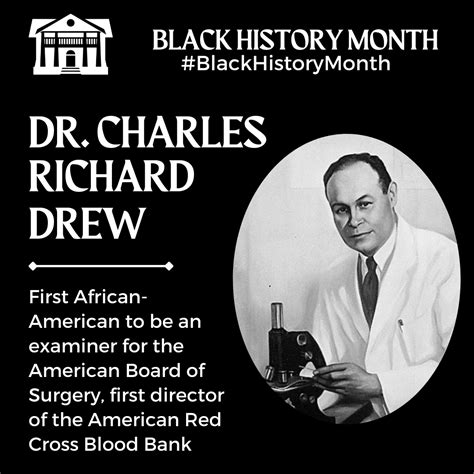Charles Drew Black History

Charles Richard Drew, a pioneering medical doctor and surgeon, left an indelible mark on the fields of medicine and healthcare with his groundbreaking contributions to blood transfusion and blood banking. His innovative work not only revolutionized the practice of medicine but also saved countless lives. Born on June 3, 1904, in Washington, D.C., Drew's journey from a small town to becoming a revered medical figure is a testament to his unwavering dedication and passion for serving humanity.
Early Life and Educational Pursuits

Charles Drew’s early life was marked by a deep interest in science and a desire to make a difference. Growing up in Washington, he attended Dunbar High School, an academically rigorous institution known for its focus on excellence. Here, Drew’s academic prowess and curiosity about the world around him were nurtured.
After completing his high school education, Drew pursued a bachelor's degree in zoology at Amherst College in Massachusetts. His time at Amherst was a transformative period, not just academically but also socially. Drew, an avid athlete, was a standout on the college's football team and was even inducted into the Amherst College Athletics Hall of Fame. This period laid the foundation for his future leadership and teamwork skills, qualities that would serve him well in his medical career.
Upon graduating from Amherst with honors, Drew's academic journey took him to McGill University in Montreal, Canada, where he enrolled in the medical program. Here, his exceptional intellect and dedication to the medical field were recognized. He excelled in his studies, earning numerous awards and distinctions. Drew's time at McGill not only equipped him with the necessary medical knowledge but also shaped his perspective on healthcare, laying the groundwork for his future contributions to the field.
The Birth of a Revolutionary Idea: Blood Banking

Charles Drew’s medical career took a pivotal turn when he became interested in the emerging field of blood transfusion. At a time when blood transfusions were still in their infancy, Drew recognized the immense potential of this life-saving technique. He embarked on a quest to understand the intricacies of blood storage and transportation, aiming to make blood transfusions more accessible and effective.
Drew's groundbreaking research focused on developing methods to preserve blood for extended periods. He discovered that by separating the plasma from the red blood cells and refrigerating them separately, blood could be stored for a significantly longer time. This innovation, known as blood plasma banking, revolutionized the way blood transfusions were conducted. It meant that blood could be stored and transported over long distances, making it available to those in need whenever and wherever required.
Drew's work was not merely an academic exercise. He recognized the practical implications of his research and its potential to save lives on a grand scale. During World War II, Drew's expertise in blood banking was put to the test. He was appointed as the medical director of the Blood for Britain project, an initiative to collect and transport blood plasma from the United States to the United Kingdom to support the war effort. Under Drew's leadership, the project was a resounding success, ensuring that wounded soldiers received the life-saving transfusions they needed.
Breaking Barriers and Advancing Equality
Charles Drew’s contributions to medicine and healthcare extended beyond his groundbreaking research. He was also a staunch advocate for racial equality and civil rights. As an African American, Drew faced numerous challenges and barriers in his professional journey. However, he refused to be deterred by the prejudices of the time, instead using his platform to promote equality and justice.
Drew's leadership in the medical community was instrumental in breaking down racial barriers. He became the first African American to earn a Doctor of Medical Science degree from Columbia University, a testament to his academic excellence and resilience in the face of adversity. Drew's achievements paved the way for future generations of African American medical professionals, inspiring them to pursue their dreams despite the challenges they might face.
Beyond his medical career, Drew was actively involved in civil rights movements. He served as the director of the Blood Bank of the National Research Council and the American Red Cross, where he fought for the integration of blood donation and transfusion services. Drew believed that blood, regardless of its donor's race, had the same potential to save lives. His efforts to promote racial equality in the medical field were a powerful statement against the prevailing racist ideologies of the time.
Legacy and Impact
Charles Drew’s legacy is a testament to his unwavering commitment to serving humanity. His groundbreaking research in blood banking not only revolutionized medical practices but also saved countless lives. Drew’s contributions continue to shape the field of transfusion medicine, ensuring that blood is readily available for those in need.
Beyond his scientific achievements, Drew's leadership and advocacy for racial equality left an indelible mark on society. His life and work serve as a powerful reminder of the importance of perseverance, excellence, and the pursuit of justice. Drew's legacy inspires future generations to challenge inequality, promote inclusivity, and strive for a better world.
Today, Charles Drew's name is synonymous with excellence, innovation, and equality. His story is a powerful reminder of the impact one individual can have on the world. Drew's contributions to medicine and his unwavering commitment to social justice continue to inspire and guide us, making him a true icon of Black history and a beacon of hope for future generations.
Awards and Recognition
Charles Drew’s contributions to medicine and society were recognized through numerous awards and honors. He was awarded the Spingarn Medal by the NAACP in 1944, acknowledging his outstanding achievements in the field of medicine. Additionally, Drew received the E.S. Jones Award from the National Medical Association, a prestigious honor for his contributions to the advancement of medical science.
| Award | Year |
|---|---|
| Spingarn Medal | 1944 |
| E.S. Jones Award | 1944 |

Impact on Blood Transfusion Practices
Drew’s innovative techniques in blood storage and transportation had a profound impact on blood transfusion practices. His discovery that plasma could be separated and stored for extended periods revolutionized the field. It allowed for the establishment of blood banks, ensuring a steady supply of blood for medical emergencies and surgical procedures. Drew’s work significantly improved patient care and survival rates, particularly in wartime situations and during medical crises.
Advocacy for Racial Equality
Charles Drew’s advocacy for racial equality extended beyond his professional achievements. He was a vocal supporter of the civil rights movement, using his platform to advocate for equal opportunities and justice. Drew’s leadership in the medical community played a crucial role in breaking down racial barriers and promoting diversity in healthcare. His legacy continues to inspire efforts towards creating a more inclusive and equitable healthcare system.
Future Implications
Charles Drew’s work in blood banking and transfusion medicine continues to have far-reaching implications. His research laid the foundation for modern blood banking practices, ensuring the availability of safe and effective blood transfusions. Drew’s contributions have not only saved lives but also advanced medical research and treatment options. His legacy inspires ongoing efforts to improve blood donation processes, enhance transfusion safety, and expand access to blood products for patients in need.
How did Charles Drew’s work impact blood transfusion practices during World War II?
+Charles Drew’s expertise in blood banking played a crucial role during World War II. He was instrumental in the Blood for Britain project, ensuring that wounded soldiers received the life-saving blood transfusions they needed. His innovative techniques in blood storage and transportation allowed for the efficient collection and distribution of blood plasma, making a significant impact on the war effort.
What challenges did Charles Drew face as an African American medical professional?
+Charles Drew faced numerous challenges and barriers due to the racial prejudices of the time. Despite these obstacles, he persevered and achieved remarkable success in his medical career. His determination and resilience inspired future generations of African American medical professionals to pursue their dreams and break down racial barriers in the healthcare field.
How did Charles Drew’s work influence the establishment of blood banks?
+Charles Drew’s research on blood storage and transportation was a major factor in the establishment of blood banks. His discovery that plasma could be separated and stored for extended periods allowed for the creation of blood banks, ensuring a steady supply of blood for medical emergencies and surgical procedures. Drew’s work revolutionized the way blood transfusions were conducted, making them more accessible and effective.



